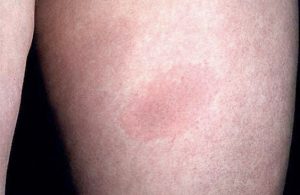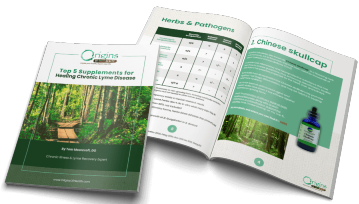How Likely Are You to Contract Lyme Disease from a Tick Bite?
Let’s talk about Lyme disease and its transmission after a tick bite. Whether you’re hiking in the woods or you live in an area that’s known for Lyme disease, it’s best to be prepared with an accurate understanding of how Lyme disease which is caused by the disease borrelia burgdorferi that ticks transfer to humans. And if you find a tick, you’ll want to know how to properly remove it along with what your prophylactic options are for preventing Lyme disease.
How Quickly Can You Contract Lyme Disease?
There’s a common misbelief that a deer tick has to be attached for 36 – 48 hours to transmit Lyme disease. However, researchers studied animal models and discovered that transmission can occur in under 16 hours. These researchers also argued that no minimum attachment time for transmission had ever been established.
In other words, no one really knows how long a tick has to be attached before Lyme disease can be transmitted to its host.
There are at least three cases in the medical literature showing that Lyme disease can be transmitted in less than 24 hours.[1] I have a case in my practice where we found DNA evidence, definitive proof based on patient history and blood tests, that our patient had contracted Lyme disease from an infected deer tick in less than 24 hours.
When my practice went to present this case and offer it up for publication, we were told that while the science was solid, it wasn’t something people needed to know.
That’s frustrating.
These are facts that people need to be aware of, especially when talking about the transmission of a debilitating disease and especially when we are using outdated research as a diagnostic tool. We cannot ignore data-backed research to “protect” people. That methodology is a potentially dangerous approach to medicine.
It’s important to understand that transmission can occur in less than 24 hours. There are even cases where patients contracted anaplasmosis in as little as 8 hours. [2] Anaplasmosis is another tick-borne infection that can spread from that same deer tick that transmits Lyme.
This means that transmission can most likely happen at any point.
What Is the Window for Contracting Lyme Disease?
Adult ticks will feed for a period of around five days. On the first day, there’s probably less than a 5 percent transmission rate. But it’s not zero. It’s also worth noting that these statistics are based on really old science, science that badly needs to be updated with more in-depth studies.
Nymph deer ticks, the ticks responsible for 95 percent of the Lyme disease out there, only feed for four days. So, if you take that five day period with an adult tick and squish it down into a window of four days, you’ll see that your risk of transmission in that first day or two increases slightly.
Most people will agree that the risk of contracting Lyme disease increases with each day the tick feeds on the host. However, it is a mistake to believe that there is zero risk of contracting the disease on the first day. [3]
Research has shown that ticks with Lyme spirochetes living in their guts spread infection when these spirochetes swim into their hosts during feeding. [4] However, there is also evidence of ticks with Lyme spirochetes in their salivary glands. [5] When that happens, transmission could happen shortly after the initial bite. To better understand this, we need to look at how a tick feeds.
How a Tick Bites You
A tick doesn’t bite in the traditional sense. It starts off by injecting you with an anesthetic. The anesthetic is necessary as it prevents you from feeling the tick begin the slow process of burrowing into you. Then the tick uses its external mouthparts to dig away flesh as it works its way into the skin.
As it digs, another part of its mouth known as the hypostome follows until the skin has been pierced. [6] The hypostome contains barbs along its entire surface that help secure the tick in place as it feeds.
It’s important to note that there are some people who have a reaction to the tick’s anesthetic and will get itchy from the bite. This is actually a positive side-effect because those people will feel the bite a lot sooner than those who don’t feel anything, increasing the chances of them discovering the tick.
Ticks also inject an anticoagulant, essentially a blood thinner, to keep the blood flowing so that they can consume their blood meal. The anticoagulant comes out of the salivary glands. And if there are spirochetes in their salivary glands, then it’s theoretically possible for near instantaneous transmission to occur.
If you’re in an area where Lyme disease is rampant, you’ll see a lot of infected ticks, making any tick bite a high-risk chance for contracting the disease. But what can you do if you find out that you’ve been bitten by a tick? How can lower your chances of contracting Lyme disease?
How to Properly Remove a Tick
If you’ve been bitten by a tick, it’s important to follow the proper removal procedure to reduce the risk of contracting Lyme disease:
- Find a pair of very sharp tweezers with a needle tip
- Grab the tick as close to the skin as possible
- Lift up from the skin and hold
- Wait until the tick releases
Be aware that the tick could take anywhere from a few seconds to a few minutes to release. It’s important to be patient so that the tick naturally unhooks its mouthparts.
When removing a tick, Do NOT:
- Twist
- Force the tick out
- Yank it out suddenly
- Apply salves or essential oils
Most alternatives methods for tick removal aren’t backed by solid science and could actually increase your chances of contracting Lyme disease from an infected tick. These methods tend to irritate the tick. Irritated ticks use “jet propulsion” through rapid regurgitation to quickly remove their mouthparts. As the tick expels its blood meal to escape, it can transmit infected blood back into your bloodstream and increase the likelihood of infection.
Can Prophylactic Treatment Prevent the Transmission of Lyme Disease?
Once we’ve removed the tick and cleaned the area, we have a few prophylaxis options. One particular study in prophylaxis focused on a single Doxycycline 200 milligrams provided to the patient once. This study used the erythema migrans “bullseye” rash that typically forms on the skin surrounding the bite from an infected tick as a diagnostic tool. [7]

Example of an Erythema migrans rash. Please note a “bull’s eye” appearance occurs in only 20-30% of Erythema migrans Lyme rashes. Image courtesy of Dermnet Skin Disease Atlas
The study argued that a single dose of doxycycline could prevent the rash with the assumption that preventing the rash meant preventing Lyme disease. The problem is that the rash is that according to the CDC about a third of people with Lyme never present with a rash. [8] More so, the medical literature shows that cases where a rash presents only happen between 40 to 60 percent of the time
That means that roughly half of the patients don’t present with a rash. And this is from confirmed cases by the strictest epidemiologic research criteria. In clinical practice, we see lots of people with evidence of Lyme who don’t remember a rash at all, and that percentage is actually lower than 50 percent.
Basically, that study promoted rash prevention in 50 percent of people, not the treatment of Lyme disease. The major problem with the study was that people still contracted Lyme disease. The study was flawed.
Basically, that study reported that a single dose doxycycline prevents the Lyme rash; however, it did not show this treatment approach prevented patients from getting Lyme disease. In fact, the study identified 3 patients with clinical and laboratory evidence of early Lyme disease who did NOT have have an EM rash at the bite site. Additionally, one patient in the study DID get Lyme, but their results were not included in the risk-benefit assessment.
For a more comprehensive review of this topic, check out the ILADS Treatment Guidelines. [9]
The other issue is that if we give you a single dose of an antibiotic, we may prevent you from getting the rash. However, you may still get Lyme. It may also prevent you from developing antibodies in your blood. If we prevent antibody and rash development, then two of our major diagnostic tools are no longer available to aid in appropriate diagnosis.
What’s frightening is that you can have the symptoms of Lyme disease, but now without rash, and then your blood tests are negative. When get tested, the doctors then say, “Oh, it’s not Lyme. It’s probably something else.” This would leave you with a misdiagnosis that could lead to chronic Lyme disease. [10]
I strongly recommend against a single dose of the doxycycline because it’s not shown to work. The problem I’ve seen is that a lot of people, particularly pediatricians, make the assumption that “if you could use one dose of doxy, you can use a single dose of amoxicillin or cefuroxime (Ceftin)” or any of these other antibiotics that are acceptable in really young kids.
But that’s not been appropriately studied, so we have no idea whether that’s going to work or not work.
What’s Your Best Option to Prevent Lyme Disease?
While there are other approaches to prophylaxis, the studies are scant, to be honest. The only really good studies out there are two performed on mice using a long-acting Doxycycline. This would be the equivalent to a 20-day dose of the Doxycycline in people. In the first study, the result was 100 percent prevention of Lyme disease. [11] In the second study, the results was 100 percent prevention of Lyme disease and Anaplasmosis. [12]
There haven’t been any studies similar to this one performed on humans, but this study serves as a decent model. A lot of us in the medical field believe that if you live in an area where Lyme disease is prevalent and deer tick bites you, then you really should get at least a 20-day course of an antibiotic to help prevent it. However, all we can really say in this case is that Doxycycline works well because we don’t have an answer for other antibiotics.
Many practitioners I know will prescribe a 4-6 week treatment right off the bat. I tend to suggest a 3-week course, reassessing the patient right before that ends and determining if there is anything else that needs to be done.
It’s important to note that the literature out there really doesn’t show us that a single dose is going to work. The best we have are those two mouse studies that shows that 20-day Doxycycline course will work to prevent the transmission of Lyme.
Many of us who treat a lot of Lyme disease have used other antibiotics as well as herbal treatments as successful prophylactic treatments, however there are no good studies to confirm our clinical findings. More research is certainly needed.
Prophylactic Treatment on a Case by Case Basis
Currently, prophylactic treatment following a deer tick bite is not commonplace. I hope that someday prophylactic treatment will be discussed with patients by licensed healthcare providers following every deer tick bite, and when these discussions happen, my hope is that they will be directed by the most up to date medical research available. Based upon the best we know at the moment, in most cases, a 21-day course would be an appropriate starting point for preventative treatment for Lyme disease.
Remember that all the research studies out there, the online videos, and the written guidelines serve as a guideline. Use this information as another guideline for when talking to your doctor about Lyme disease and the possible prophylactic treatment options to help prevent the disease.
Sources:
- https://www.sciencedirect.com/science/article/pii/S0732889311004159?via%3Dihub
- https://www.ct.gov/caes/lib/caes/documents/publications/bulletins/b1010.pdf pp28-29
- https://medicalxpress.com/news/2018-09-lyme-disease-transmission-infected.html
- http://www.ucmp.berkeley.edu/bacteria/spirochetes.html
- https://www.ncbi.nlm.nih.gov/pmc/articles/PMC5479950/
- https://www.kqed.org/science/1920972/how-ticks-dig-in-with-a-mouth-full-of-hooks
- https://www.cdc.gov/lyme/signs_symptoms/rashes.html
- https://www.cdc.gov/lyme/signs_symptoms/index.html
- https://www.tandfonline.com/doi/full/10.1586/14787210.2014.940900
- https://www.ilads.org/research-literature/controversies-challenges/
- https://www.ncbi.nlm.nih.gov/pmc/articles/PMC434223/
- https://www.ncbi.nlm.nih.gov/pubmed/18349366?dopt=Abstract


